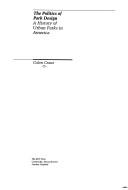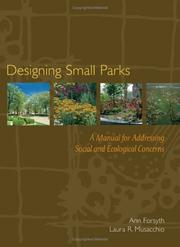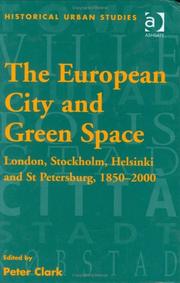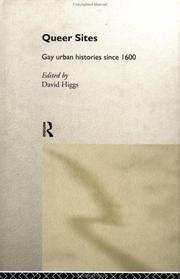| Listing 1 - 10 of 24 | << page >> |
Sort by
|

ISBN: 0262030861 0262367866 9780262367868 9780262030861 0262530848 Year: 1982 Publisher: Cambridge, Mass. : MIT Press,
Abstract | Keywords | Export | Availability | Bookmark
 Loading...
Loading...Choose an application
- Reference Manager
- EndNote
- RefWorks (Direct export to RefWorks)
Galen Cranz surveys the rise of the park system from 1850 to the present through 4 stages - the pleasure ground, the reform park, the recreation facility and the open space system. Looking at both their physical design and social purpose, Cranz argues that city parks have become an instrument of social policy with the potential for reflecting and serving social values.
Urban parks --- History. --- Design and construction --- Political aspects --- -Urban parks --- -Central city parks --- City parks --- Municipal parks --- Parks --- Public spaces --- -Political aspects --- -History --- -Design and construction --- History --- Central city parks --- ARCHITECTURE/Urban Design

ISBN: 0471736805 9780471736806 Year: 2005 Publisher: Hoboken Wiley & sons
Abstract | Keywords | Export | Availability | Bookmark
 Loading...
Loading...Choose an application
- Reference Manager
- EndNote
- RefWorks (Direct export to RefWorks)
Parken --- 712.253 --- Groenvoorziening (groenbeleid) --- Parken, openbare tuinen --- Urban parks --- Central city parks --- City parks --- Municipal parks --- Parks --- Public spaces --- Design --- Design&delete& --- Environmental aspects --- Social aspects
Book
ISBN: 3961714401 9783961714407 Year: 2023 Publisher: Augsburg : teNeues,
Abstract | Keywords | Export | Availability | Bookmark
 Loading...
Loading...Choose an application
- Reference Manager
- EndNote
- RefWorks (Direct export to RefWorks)
"Former runways, abandoned buildings, disused railways and more: discover the urban spaces worldwide that have been transformed into green havens. Showcasing the transformative power of nature in today’s cities, Urban Oasis is a journey through the innovative and inspiring green city spaces rising around the world to meet the challenges of the climate crisis and social inequality. From Berlin‘s Tempelhof Airport, now a thriving public space, to the former landfill site transformed into Cairo’s Al-Azhar Park,to Bangkok’s Thammasat University Urban Farm, the largest organic rooftop farm in Asia, the forward-thinking green projects featured in this stunning book offer abundant glimpses of a greener future."-- Provided by publisher.
Urban parks --- City planning --- Environmental aspects --- Central city parks --- City parks --- Municipal parks --- Parks --- Public spaces --- Design urbain. --- Parcs. --- Gardening --- Urban plants --- Landschapsarchitectuur --- publieke ruimte

ISBN: 075465429X Year: 2006 Publisher: Aldershot Ashgate
Abstract | Keywords | Export | Availability | Bookmark
 Loading...
Loading...Choose an application
- Reference Manager
- EndNote
- RefWorks (Direct export to RefWorks)
City planning --- Greenways --- Open spaces --- Urban parks --- History --- Saint Petersburg --- SINT-PETERSBURG -- 911.07 --- HELSINKI -- 911.07 --- Environmental planning --- anno 1800-1999 --- Helsinki --- Stockholm --- London --- Land use --- Linear parks --- Central city parks --- City parks --- Municipal parks --- Parks --- Public spaces --- Espaces verts --- Parcs urbains --- Urbanisme --- History. --- Histoire --- Built environment
Book
ISBN: 9788409098804 8409098806 Year: 2019 Publisher: Vitoria-Gasteiz, Spain : a+t architecture publishers,
Abstract | Keywords | Export | Availability | Bookmark
 Loading...
Loading...Choose an application
- Reference Manager
- EndNote
- RefWorks (Direct export to RefWorks)
The fifth volume of the ‘Strategy’ series is dedicated to urban parks. Through a selection of projects, the magazine identifies and analyses design strategies with which to create accessible, natural paradises for the urban dweller. To study the projects from the perspective of these strategies is to venture into the relationships that emerge between them, and – as a consequence – between the projects themselves. Initiated in 2010, the ‘Strategy’ series defines scalar scopes, evidences disciplinary origins, and composes a grid that overlaps the project to offer a new vision of it.
Urban parks --- Urban landscape architecture --- 712.25 --- 712 --- 711.61 --- 711.4 --- 712.2 --- 712.2 Planologie van landschappen--(algemeen) --- Planologie van landschappen--(algemeen) --- Landscape architecture --- Parks --- Public spaces --- Central city parks --- City parks --- Municipal parks --- Design --- Openbare parken --- Openbare tuinen --- Landschapsarchitectuur --- Publieke ruimte --- Openbare ruimte --- Tuinarchitectuur --- Stedenbouw --- Urban parks. --- Urban landscape architecture. --- Parken --- publieke ruimte
Book
ISBN: 1683506529 9781683506522 1683506510 Publisher: [Place of publication not identified] MORGAN JAMES PUBLISHING.
Abstract | Keywords | Export | Availability | Bookmark
 Loading...
Loading...Choose an application
- Reference Manager
- EndNote
- RefWorks (Direct export to RefWorks)
Describes the history, vision and impact of The Urban Ecology Center in Milwaukee, Wisconsin and its model for urban environmental education. Strategies that can be used elsewhere called the Neighborhood Environmental Education Project are included.
Urban ecology (Sociology) --- Urban parks --- Central city parks --- City parks --- Municipal parks --- Parks --- Public spaces --- Cities and towns --- Urban ecology --- Urban environment --- Social ecology --- Sociology, Urban --- Environmental aspects --- Urban Ecology Center (Milwaukee, Wis.) --- Wisconsin --- U.E.C. (Urban Ecology Center) --- UEC (Urban Ecology Center)

ISBN: 0203171292 1134724683 1280332492 0203028740 9780203171295 9780203028742 9780415158978 0415158974 9780415158985 0415158982 9786610332496 6610332495 9781134724680 9781134724635 1134724632 9781134724673 1134724675 Year: 1999 Publisher: London New York Routledge
Abstract | Keywords | Export | Availability | Bookmark
 Loading...
Loading...Choose an application
- Reference Manager
- EndNote
- RefWorks (Direct export to RefWorks)
There are areas which can be described as gay space in that they have many lesbians and gays in the population. Queerspace: A History of Urban Sexuality, edited by David Higgs, offers a history of gay space in the major cities form the early modern period to the present. The book focuses on the changing nature of queer experience in London, Amsterdam, Rio de Janiero, San Francisco, Paris, Lisbon and Moscow. This book provides an interdisciplinary analysis of extensive source material, including diaries, poems, legal accounts and journalism. By concentrating the importance of the c
Gay men --- City and town life --- Public spaces --- Urban parks --- Gays, Male --- Homosexuals, Male --- Male gays --- Male homosexuals --- Urnings --- Gays --- Men --- Central city parks --- City parks --- Municipal parks --- Parks --- Public places --- Social areas --- Urban public spaces --- Urban spaces --- Cities and towns --- City life --- Town life --- Urban life --- Sociology, Urban --- History. --- Social life and customs.
Book
ISBN: 9780643106994 0643106995 1299639453 9781299639454 9780643107007 0643107002 9780643103214 064310321X Year: 2013 Publisher: Collingwood, Vic. CSIRO Publishing
Abstract | Keywords | Export | Availability | Bookmark
 Loading...
Loading...Choose an application
- Reference Manager
- EndNote
- RefWorks (Direct export to RefWorks)
All about Western Australian plants, based on decades of research, experimentation and application at Kings Park and Botanic Garden.
Endemic plants --- Urban parks --- Botanical gardens --- Botanic gardens --- Gardens --- Research institutes --- Arboretums --- Central city parks --- City parks --- Municipal parks --- Parks --- Public spaces --- Indigenous plants --- Native plants --- Native vegetation --- Plants --- Kings Park and Botanic Garden (West Perth, W.A.) --- Kings Park & Botanic Garden (West Perth, W.A.) --- Kings Park (Perth, W.A.) --- Australian
Book
ISBN: 1317085841 1317085833 1409440044 9781409440048 9781472404091 1472404092 1322012245 9781322012247 9781409440031 1409440036 9781317085843 9781317085836 9781315598833 9781317085829 9781138246218 1315598833 Year: 2014 Publisher: Surrey, England ; Burlington, Vermont : Ashgate,
Abstract | Keywords | Export | Availability | Bookmark
 Loading...
Loading...Choose an application
- Reference Manager
- EndNote
- RefWorks (Direct export to RefWorks)
Through an in-depth ethnographic examination of London's 'South Bank', this book explores the value widely presupposed on urban public space. Based on subjective accounts of the value of public space, as well as observations of how the South Bank is used and 'practised' on a daily basis, it argues that this value is not so much inherent to physical public space itself as it is derived through the everyday use and production of that space. Public space is valued not only for its essential material characteristics but also for the productive potential that these characteristics, if properly mana
Public spaces --- Social interaction --- Urban parks --- Public places --- Social areas --- Urban public spaces --- Urban spaces --- Cities and towns --- Central city parks --- City parks --- Municipal parks --- Parks --- Human interaction --- Interaction, Social --- Symbolic interaction --- Exchange theory (Sociology) --- Psychology --- Social psychology --- Social aspects --- South Bank (London, England) --- Southbank (London, England)
Book
ISBN: 022673918X 9780226739182 9780226738994 9780226739045 Year: 2021 Publisher: Chicago : University of Chicago Press,
Abstract | Keywords | Export | Availability | Bookmark
 Loading...
Loading...Choose an application
- Reference Manager
- EndNote
- RefWorks (Direct export to RefWorks)
As projects like Manhattan’s High Line, Chicago’s 606, China’s eco-cities, and Ethiopia’s tree-planting efforts show, cities around the world are devoting serious resources to urban greening. Formerly neglected urban spaces and new high-end developments draw huge crowds thanks to the considerable efforts of city governments. But why are greening projects so widely taken up, and what good do they do? In How Green Became Good, Hillary Angelo uncovers the origins and meanings of the enduring appeal of urban green space, showing that city planners have long thought that creating green spaces would lead to social improvement. Turning to Germany’s Ruhr Valley (a region that, despite its ample open space, was “greened” with the addition of official parks and gardens), Angelo shows that greening is as much a social process as a physical one. She examines three moments in the Ruhr Valley’s urban history that inspired the creation of new green spaces: industrialization in the late nineteenth century, postwar democratic ideals of the 1960s, and industrial decline and economic renewal in the early 1990s. Across these distinct historical moments, Angelo shows that the impulse to bring nature into urban life has persistently arisen as a response to a host of social changes, and reveals an enduring conviction that green space will transform us into ideal inhabitants of ideal cities. Ultimately, however, she finds that the creation of urban green space is more about how we imagine social life than about the good it imparts.
Urban parks. --- Public spaces --- Nature and civilization. --- Environmental aspects. --- Central city parks --- City parks --- Municipal parks --- Parks --- Civilization and nature --- Civilization --- Public places --- Social areas --- Urban public spaces --- Urban spaces --- Cities and towns --- Sociology of environment --- Germany. --- Ruhr. --- morality. --- social imaginaries. --- urban greening. --- urban nature. --- urban theory. --- urbanization. --- urbanized nature. --- Public spaces. --- Nature and civilization
| Listing 1 - 10 of 24 | << page >> |
Sort by
|

 Search
Search Feedback
Feedback About UniCat
About UniCat  Help
Help News
News